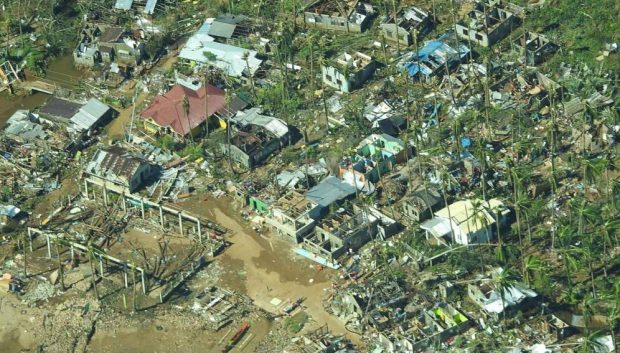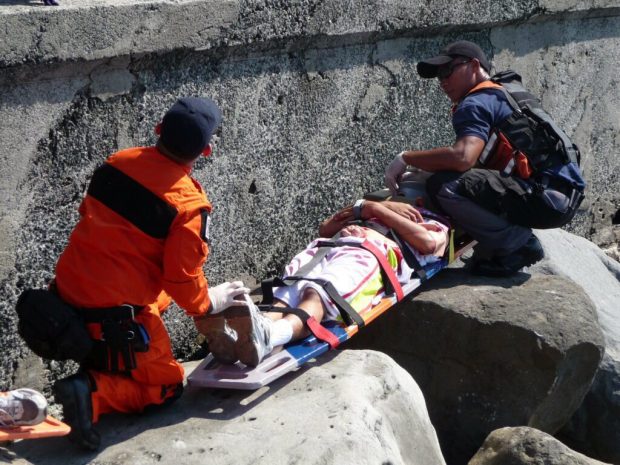
Climate crisis is here – Lessons not learned

Surigao City in Mindanao, Philippines was one of the areas devastated by Typhoon Rai, locally known in the Philippines as “Odette”. (Photo: Philippine Coast Guard, Public domain).
By Crispin Maslog
MANILA: Exactly ten years ago in January 2012, as a retired science journalism professor, I wrote my first column for SciDev.Net.
It was about the flash floods caused by the wayward Pacific typhoon Washi (locally called Sendong) that swept some 1,500 people to their deaths overnight and left at least 2,000 missing in the southern Philippine island of Mindanao.
The months-long floods inundated not only the Philippines but also most of South-East Asia towards the end of 2011. The floods were an urgent warning that Association of Southeast Asian Nations (ASEAN) governments needed to take climate change seriously. Unfortunately, they have not.
A decade later I am still writing for the Asia Pacific edition of SciDev.Net, and about another storm, Typhoon Rai (local name Odette). Although not as violent as super Typhoon Haiyan in 2013, Rai still caused widespread destruction even with only 195 kilometres per hour winds with occasional gusts of 240 kilometres per hour, because it made nine landfalls from northern Mindanao to central Philippines on 16 December before it headed out to sea.
The Philippine National Disaster Risk Reduction and Management Council, per monitoring of media reports, said on 31 December that at least 405 individuals died due to Typhoon Rai, with at least 82 missing and 1,147 injured. Damage to agriculture reached nearly US$1.2 billion.
Some in my family were victims of the storm — a brother and sister and dozens of their children and grandchildren in northern Mindanao, where the storm started, and in Central Visayas. Although none of them was injured, this storm has been up close and personal.
What have I learned over the past decade? To put it another way, what are the lessons that we have not learned from all these natural catastrophes?
Lesson 1: Be proactive
It is time to bring our weather forecasting up to Western standards, where the weather alert is usually 10—14 days ahead. The US Weather Alert System, for example, starts monitoring weather disturbances while they are still forming in the Caribbean, since they expect such systems to hit south-eastern US. They also forecast expected strengths of the storms when they hit land — e.g. how much rain and how strong the winds to expect —unlike our local weather alerts where they often provide general forecast of the storm going stronger before hitting land.
For instance, the Philippines usually waits until the weather disturbances enter the Philippine Area of Responsibility (PAR) before raising the warning. The Philippines is the first line of defence (or attack, if you will) for Pacific typhoons. They form in the Pacific where cold air from above meets the warm ocean evaporation. As the storms build up, they head for PAR and South-East Asia before usually swerving north to Taiwan, Hongkong, Japan, China and Korea.
Lesson 2: Give immediate coordinated response
The second part of the lesson concerns response — rescue operations and aid for the victims. This aspect has improved greatly since I was a young man observing these disasters. Local governments now take pride in their disaster risk reduction teams. However, they still do not have the needed equipment and manpower — ships, helicopters and motorboats to ferry cargo and trucks to deliver the aid by land.
They also do not have the personnel specially trained and assigned for rescue operations. I suggest that a Climate Disaster Corps composed of the navy, air force and police personnel be trained for this as a permanent part of their assignments.

There is need to provide coordinated and immediate pre-positioned aid and relief response. Knowing where a storm is going to hit, the relief operations should be ready on the ground to mobilise immediately when disasters strike, and not days later as is the case at present.
Also, the response must be coordinated, unlike now. A Harvard Humanitarian Initiative (HHI) study in 2020 said, “More reciprocal, cohesive local collaborations (are) needed for Philippine disaster risk reduction.” HHI surveyed “501 international and local actors across the country from 2017 to 2019. Despite having many local actors working on disaster preparedness and resilience in the Philippines, many of them were not working cohesively.”
The Harvard study also asked why higher education and research institutions were not more involved, since they typically have greater access to Internet and partnerships with government and international non-governmental organisations.
Lesson 3: Provide quality evacuation centres
A quick look at the refugees will tell you two things — the misery of the evacuees and the decrepit evacuation centres, with their inadequate kitchen and toilet facilities and water supplies. The materials for meals might be there — but no utensils. We house refugees in poorly built school buildings and local gyms with no facilities. Government must now build properly equipped infrastructure to withstand the storms.
Isn’t it ironic that in the midst of storms and floods, people in these evacuation centres have no water to clean their toilets and no clean water for cooking and to drink? Never mind bathing. Anticipation would tell us to provide concrete water tanks and water purifiers at these centres. People can survive without food for days but will die of dysentery and cholera within days of an outbreak caused by dirty water and poor sanitation.
Local officials from the heavily affected Siargao Island reported a sudden surge in diarrhoea cases with 10 deaths at least as residents were forced to drink contaminated water from wells and leading to shortages of medicines.
In fact, many of these evacuation centres – as well as many government buildings and infrastructure – were heavily damaged during the onslaught of the storm causing some to question the build of these evacuation centres.
A recent Hong Kong study estimated that by the end of this century, storms in East and South-East Asia will be double the destructive power and expose more areas to severe storms.
Knowing that these evacuation centres will be a permanent part of the local landscape, efforts must be made to make them sturdy, weather-resistant and permanent. Such facilities should be able to withstand the strongest winds.
Lesson 4: Time to adapt
This is the most difficult and takes time. Sound urban planning is key and should start now. At the risk of repeating myself many times over, South-East Asian cities are expanding exponentially, slums are growing along seacoasts and riverbanks which are most vulnerable to floods. Governments must find ways to manage this urban growth.
Now is the time to build smart cities and villages. Climate-friendly cities with power lines and communication networks buried underground to avoid toppled electric poles and tangled wires that follow weather disasters. We must pursue more seriously planting mangroves to protect our shorelines and move cities to higher ground.
Even agriculture must adapt. A senior citizen friend of mine, who comes from the mid-section of the Philippines that faces the Pacific (Sorsogon province), has told me that farmers in their windy region have stopped planting fruit trees. Should the Philippines now develop bonsai agricultural plants and switch to more root crops instead—camotes (sweet potato), ube (purple yam), gabi (taro) and cassavas? Necessity is the mother of invention, as the saying goes.
One technology that deserves special attention in the coming rebuilding process is solar power. According to studies, the Philippines and South-East Asia have 300 days of sunshine a year and solar technology is now cheaper and available to light homes and streets. As we rebuild from this storm, we should switch to solar energy which can now be harvested in homes, offices and public buildings and will minimise use of electric wires and poles.
As the Chinese say, every crisis is an opportunity. Rai, which devastated about half of the Philippines, gives us the opportunity to build back safer, better and wiser. I hope to have a better story to report in 2022.
Crispin Maslog, a former editor at Agence France-Presse and a science journalist, taught science journalism at Silliman University and the University of the Philippines Los Banos.
This piece was produced by SciDev.Net’s Asia & Pacific desk.


